Organizational Behaviour Report: Analysis of Sainsbury's Performance
VerifiedAdded on 2021/02/19
|19
|4219
|37
Report
AI Summary
This report provides a comprehensive analysis of organizational behaviour within Sainsbury's, a major UK supermarket chain. The report begins by examining how organizational culture, power dynamics, and political influences impact team and individual behaviour, referencing Hofstede's cultural dimensions and various types of organizational politics. It then delves into motivation theories, including Maslow's hierarchy of needs and Herzberg's two-factor theory, and their application within Sainsbury's. Furthermore, the report explores process theories like Vroom's expectancy theory and Adam's equity theory, along with their practical implications for achieving organizational goals. Finally, the report discusses the importance of effective teams, comparing them to ineffective teams, and touching upon leadership theories and concepts of organizational behaviour. The report concludes with an overview of the key findings and recommendations for Sainsbury's to enhance its organizational performance.
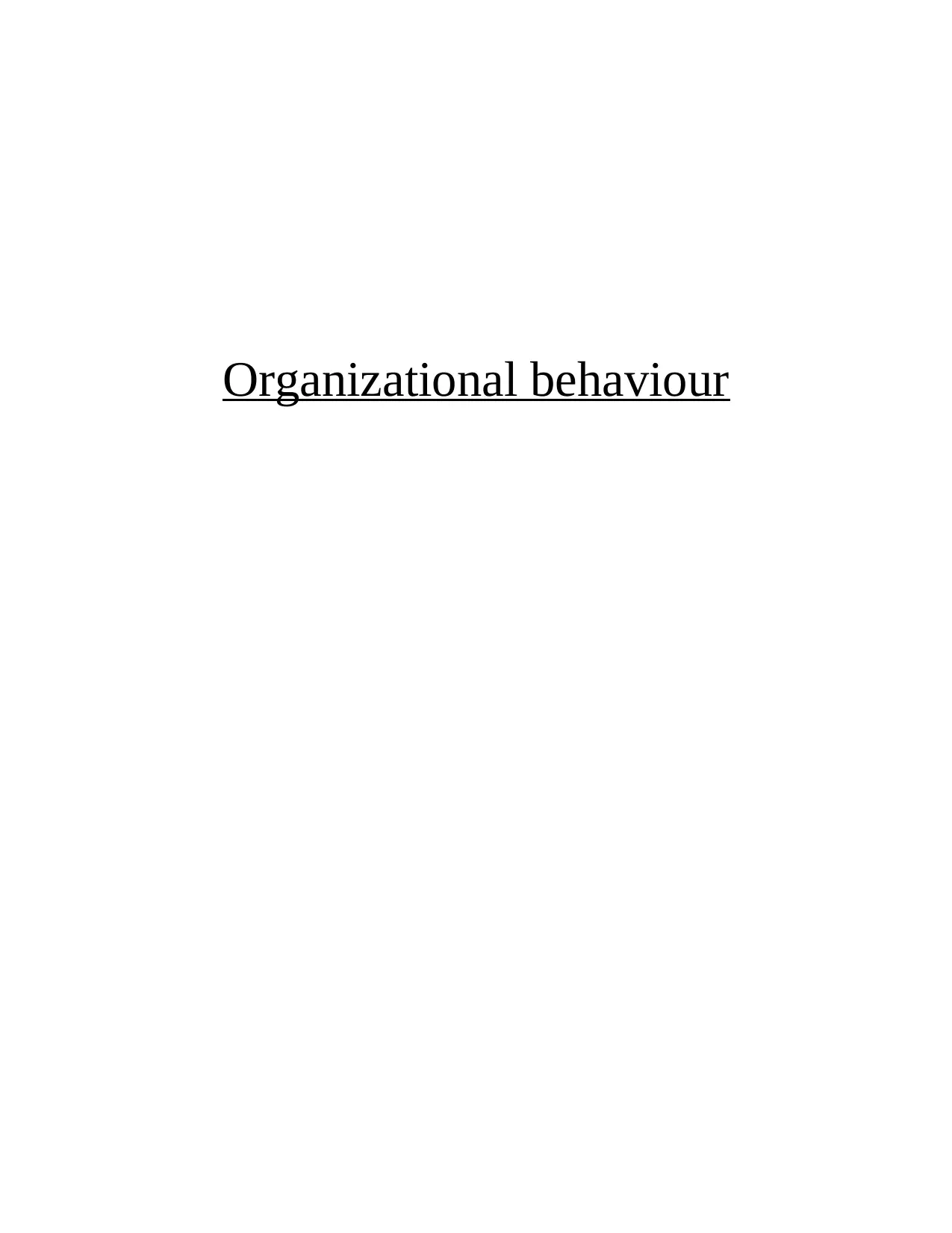
Organizational behaviour
Paraphrase This Document
Need a fresh take? Get an instant paraphrase of this document with our AI Paraphraser
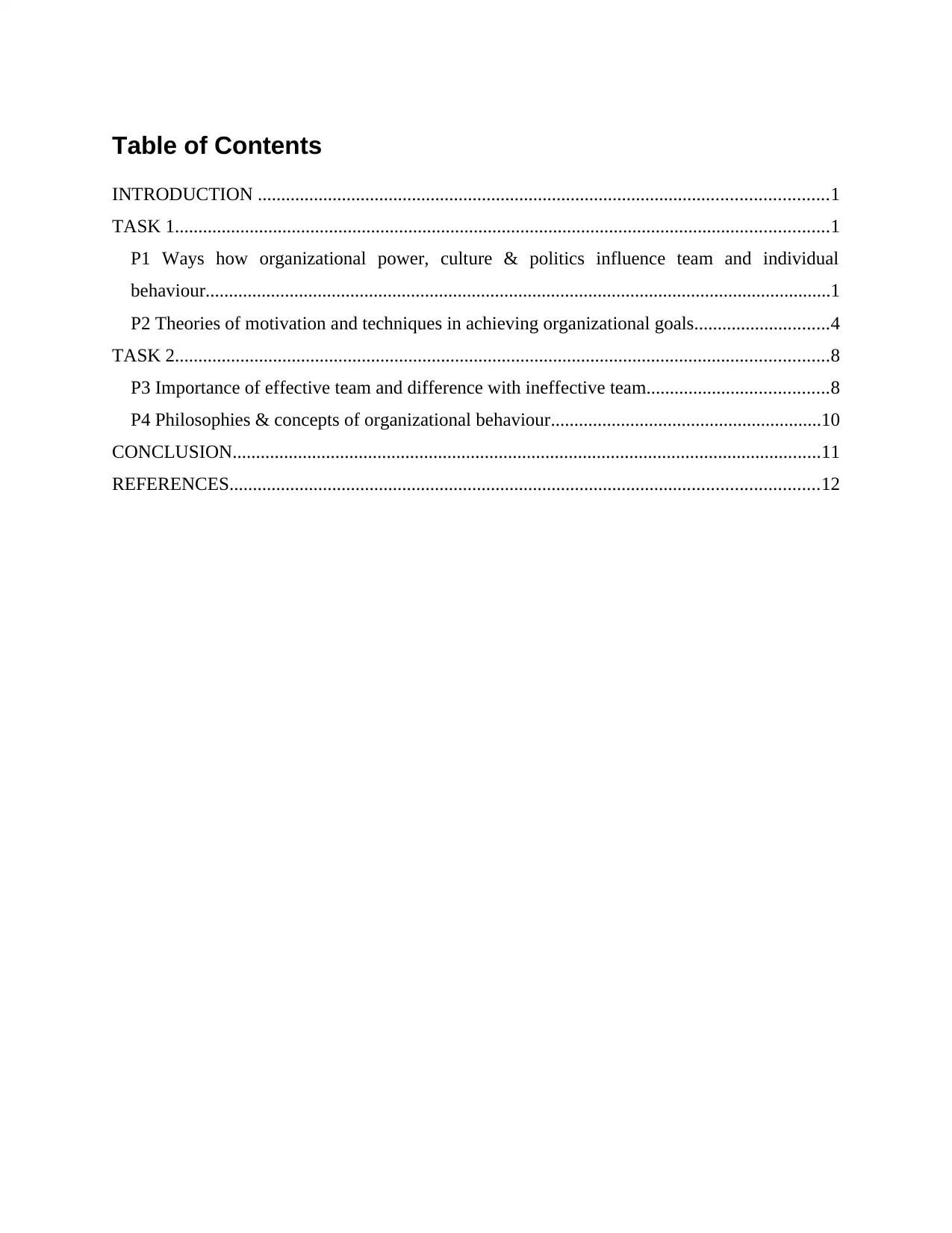
Table of Contents
INTRODUCTION ..........................................................................................................................1
TASK 1............................................................................................................................................1
P1 Ways how organizational power, culture & politics influence team and individual
behaviour......................................................................................................................................1
P2 Theories of motivation and techniques in achieving organizational goals.............................4
TASK 2............................................................................................................................................8
P3 Importance of effective team and difference with ineffective team.......................................8
P4 Philosophies & concepts of organizational behaviour..........................................................10
CONCLUSION..............................................................................................................................11
REFERENCES..............................................................................................................................12
INTRODUCTION ..........................................................................................................................1
TASK 1............................................................................................................................................1
P1 Ways how organizational power, culture & politics influence team and individual
behaviour......................................................................................................................................1
P2 Theories of motivation and techniques in achieving organizational goals.............................4
TASK 2............................................................................................................................................8
P3 Importance of effective team and difference with ineffective team.......................................8
P4 Philosophies & concepts of organizational behaviour..........................................................10
CONCLUSION..............................................................................................................................11
REFERENCES..............................................................................................................................12
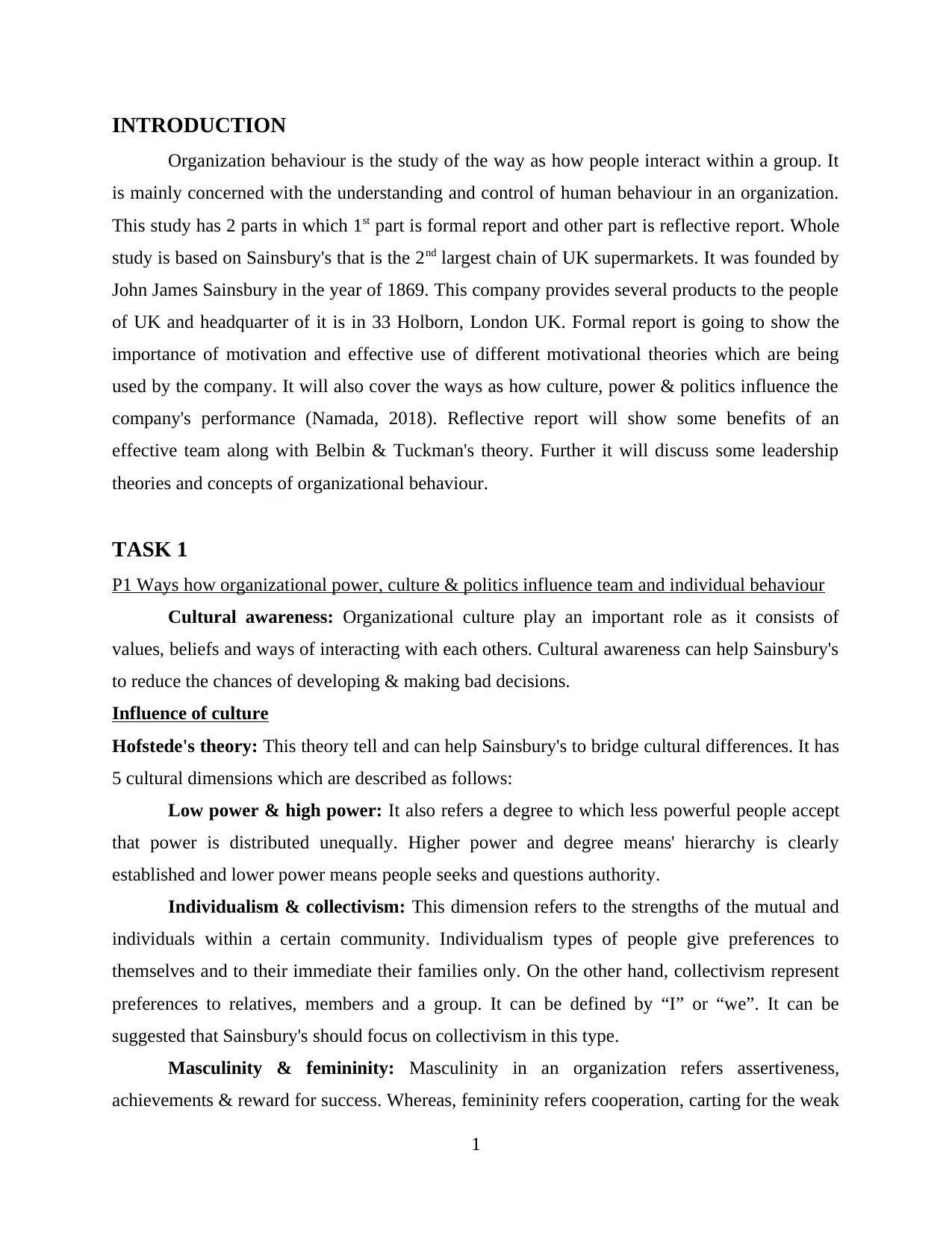
INTRODUCTION
Organization behaviour is the study of the way as how people interact within a group. It
is mainly concerned with the understanding and control of human behaviour in an organization.
This study has 2 parts in which 1st part is formal report and other part is reflective report. Whole
study is based on Sainsbury's that is the 2nd largest chain of UK supermarkets. It was founded by
John James Sainsbury in the year of 1869. This company provides several products to the people
of UK and headquarter of it is in 33 Holborn, London UK. Formal report is going to show the
importance of motivation and effective use of different motivational theories which are being
used by the company. It will also cover the ways as how culture, power & politics influence the
company's performance (Namada, 2018). Reflective report will show some benefits of an
effective team along with Belbin & Tuckman's theory. Further it will discuss some leadership
theories and concepts of organizational behaviour.
TASK 1
P1 Ways how organizational power, culture & politics influence team and individual behaviour
Cultural awareness: Organizational culture play an important role as it consists of
values, beliefs and ways of interacting with each others. Cultural awareness can help Sainsbury's
to reduce the chances of developing & making bad decisions.
Influence of culture
Hofstede's theory: This theory tell and can help Sainsbury's to bridge cultural differences. It has
5 cultural dimensions which are described as follows:
Low power & high power: It also refers a degree to which less powerful people accept
that power is distributed unequally. Higher power and degree means' hierarchy is clearly
established and lower power means people seeks and questions authority.
Individualism & collectivism: This dimension refers to the strengths of the mutual and
individuals within a certain community. Individualism types of people give preferences to
themselves and to their immediate their families only. On the other hand, collectivism represent
preferences to relatives, members and a group. It can be defined by “I” or “we”. It can be
suggested that Sainsbury's should focus on collectivism in this type.
Masculinity & femininity: Masculinity in an organization refers assertiveness,
achievements & reward for success. Whereas, femininity refers cooperation, carting for the weak
1
Organization behaviour is the study of the way as how people interact within a group. It
is mainly concerned with the understanding and control of human behaviour in an organization.
This study has 2 parts in which 1st part is formal report and other part is reflective report. Whole
study is based on Sainsbury's that is the 2nd largest chain of UK supermarkets. It was founded by
John James Sainsbury in the year of 1869. This company provides several products to the people
of UK and headquarter of it is in 33 Holborn, London UK. Formal report is going to show the
importance of motivation and effective use of different motivational theories which are being
used by the company. It will also cover the ways as how culture, power & politics influence the
company's performance (Namada, 2018). Reflective report will show some benefits of an
effective team along with Belbin & Tuckman's theory. Further it will discuss some leadership
theories and concepts of organizational behaviour.
TASK 1
P1 Ways how organizational power, culture & politics influence team and individual behaviour
Cultural awareness: Organizational culture play an important role as it consists of
values, beliefs and ways of interacting with each others. Cultural awareness can help Sainsbury's
to reduce the chances of developing & making bad decisions.
Influence of culture
Hofstede's theory: This theory tell and can help Sainsbury's to bridge cultural differences. It has
5 cultural dimensions which are described as follows:
Low power & high power: It also refers a degree to which less powerful people accept
that power is distributed unequally. Higher power and degree means' hierarchy is clearly
established and lower power means people seeks and questions authority.
Individualism & collectivism: This dimension refers to the strengths of the mutual and
individuals within a certain community. Individualism types of people give preferences to
themselves and to their immediate their families only. On the other hand, collectivism represent
preferences to relatives, members and a group. It can be defined by “I” or “we”. It can be
suggested that Sainsbury's should focus on collectivism in this type.
Masculinity & femininity: Masculinity in an organization refers assertiveness,
achievements & reward for success. Whereas, femininity refers cooperation, carting for the weak
1
⊘ This is a preview!⊘
Do you want full access?
Subscribe today to unlock all pages.

Trusted by 1+ million students worldwide
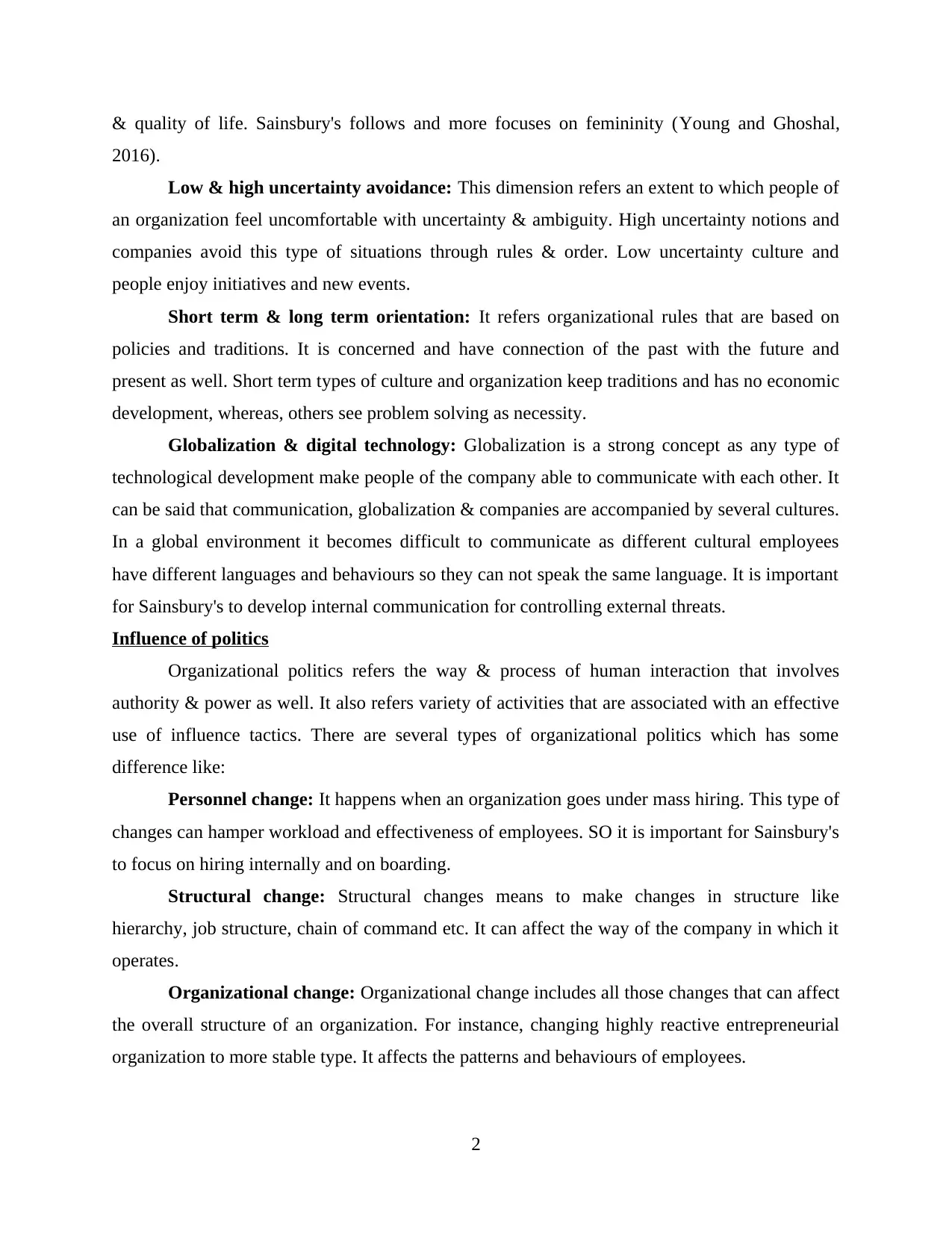
& quality of life. Sainsbury's follows and more focuses on femininity (Young and Ghoshal,
2016).
Low & high uncertainty avoidance: This dimension refers an extent to which people of
an organization feel uncomfortable with uncertainty & ambiguity. High uncertainty notions and
companies avoid this type of situations through rules & order. Low uncertainty culture and
people enjoy initiatives and new events.
Short term & long term orientation: It refers organizational rules that are based on
policies and traditions. It is concerned and have connection of the past with the future and
present as well. Short term types of culture and organization keep traditions and has no economic
development, whereas, others see problem solving as necessity.
Globalization & digital technology: Globalization is a strong concept as any type of
technological development make people of the company able to communicate with each other. It
can be said that communication, globalization & companies are accompanied by several cultures.
In a global environment it becomes difficult to communicate as different cultural employees
have different languages and behaviours so they can not speak the same language. It is important
for Sainsbury's to develop internal communication for controlling external threats.
Influence of politics
Organizational politics refers the way & process of human interaction that involves
authority & power as well. It also refers variety of activities that are associated with an effective
use of influence tactics. There are several types of organizational politics which has some
difference like:
Personnel change: It happens when an organization goes under mass hiring. This type of
changes can hamper workload and effectiveness of employees. SO it is important for Sainsbury's
to focus on hiring internally and on boarding.
Structural change: Structural changes means to make changes in structure like
hierarchy, job structure, chain of command etc. It can affect the way of the company in which it
operates.
Organizational change: Organizational change includes all those changes that can affect
the overall structure of an organization. For instance, changing highly reactive entrepreneurial
organization to more stable type. It affects the patterns and behaviours of employees.
2
2016).
Low & high uncertainty avoidance: This dimension refers an extent to which people of
an organization feel uncomfortable with uncertainty & ambiguity. High uncertainty notions and
companies avoid this type of situations through rules & order. Low uncertainty culture and
people enjoy initiatives and new events.
Short term & long term orientation: It refers organizational rules that are based on
policies and traditions. It is concerned and have connection of the past with the future and
present as well. Short term types of culture and organization keep traditions and has no economic
development, whereas, others see problem solving as necessity.
Globalization & digital technology: Globalization is a strong concept as any type of
technological development make people of the company able to communicate with each other. It
can be said that communication, globalization & companies are accompanied by several cultures.
In a global environment it becomes difficult to communicate as different cultural employees
have different languages and behaviours so they can not speak the same language. It is important
for Sainsbury's to develop internal communication for controlling external threats.
Influence of politics
Organizational politics refers the way & process of human interaction that involves
authority & power as well. It also refers variety of activities that are associated with an effective
use of influence tactics. There are several types of organizational politics which has some
difference like:
Personnel change: It happens when an organization goes under mass hiring. This type of
changes can hamper workload and effectiveness of employees. SO it is important for Sainsbury's
to focus on hiring internally and on boarding.
Structural change: Structural changes means to make changes in structure like
hierarchy, job structure, chain of command etc. It can affect the way of the company in which it
operates.
Organizational change: Organizational change includes all those changes that can affect
the overall structure of an organization. For instance, changing highly reactive entrepreneurial
organization to more stable type. It affects the patterns and behaviours of employees.
2
Paraphrase This Document
Need a fresh take? Get an instant paraphrase of this document with our AI Paraphraser
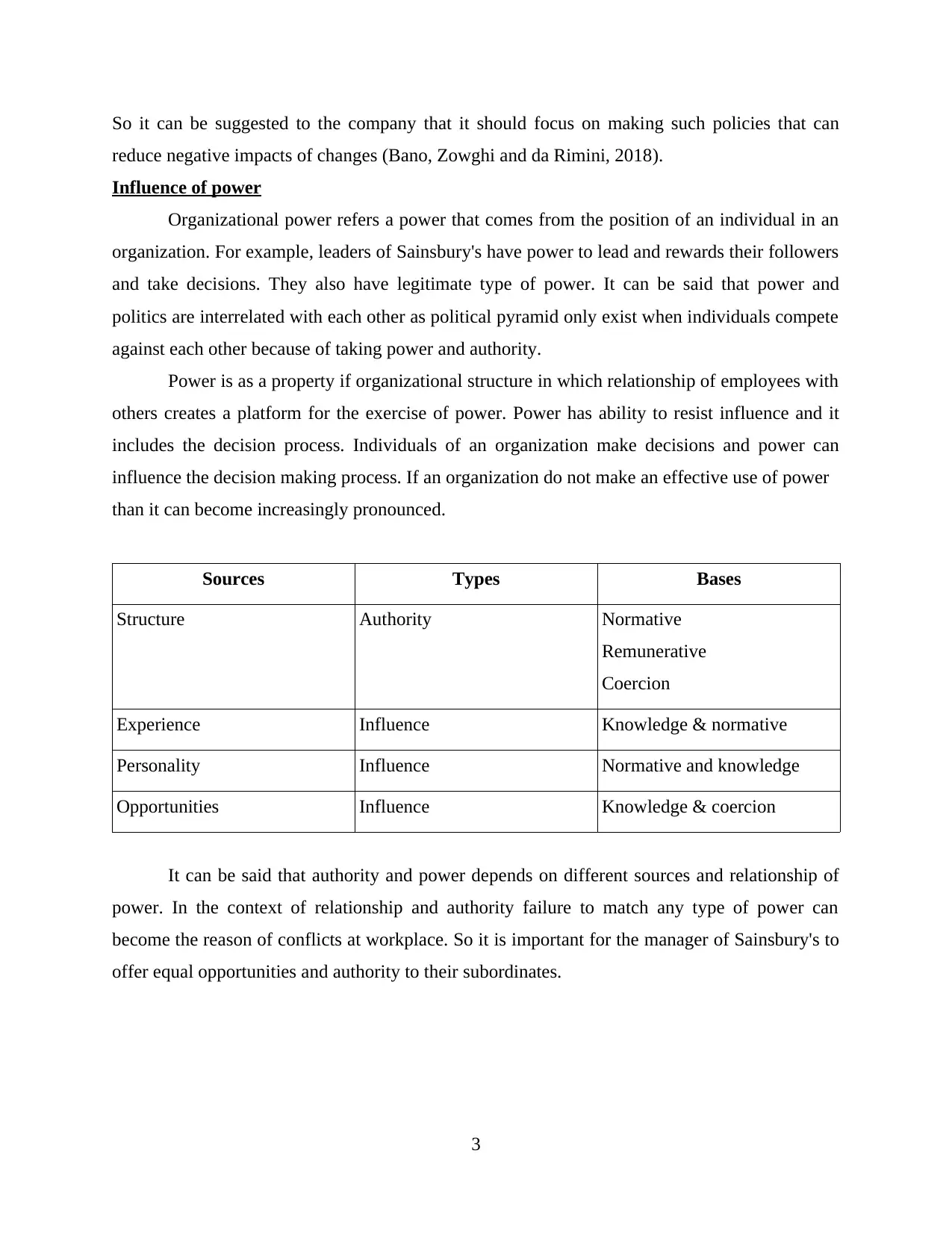
So it can be suggested to the company that it should focus on making such policies that can
reduce negative impacts of changes (Bano, Zowghi and da Rimini, 2018).
Influence of power
Organizational power refers a power that comes from the position of an individual in an
organization. For example, leaders of Sainsbury's have power to lead and rewards their followers
and take decisions. They also have legitimate type of power. It can be said that power and
politics are interrelated with each other as political pyramid only exist when individuals compete
against each other because of taking power and authority.
Power is as a property if organizational structure in which relationship of employees with
others creates a platform for the exercise of power. Power has ability to resist influence and it
includes the decision process. Individuals of an organization make decisions and power can
influence the decision making process. If an organization do not make an effective use of power
than it can become increasingly pronounced.
Sources Types Bases
Structure Authority Normative
Remunerative
Coercion
Experience Influence Knowledge & normative
Personality Influence Normative and knowledge
Opportunities Influence Knowledge & coercion
It can be said that authority and power depends on different sources and relationship of
power. In the context of relationship and authority failure to match any type of power can
become the reason of conflicts at workplace. So it is important for the manager of Sainsbury's to
offer equal opportunities and authority to their subordinates.
3
reduce negative impacts of changes (Bano, Zowghi and da Rimini, 2018).
Influence of power
Organizational power refers a power that comes from the position of an individual in an
organization. For example, leaders of Sainsbury's have power to lead and rewards their followers
and take decisions. They also have legitimate type of power. It can be said that power and
politics are interrelated with each other as political pyramid only exist when individuals compete
against each other because of taking power and authority.
Power is as a property if organizational structure in which relationship of employees with
others creates a platform for the exercise of power. Power has ability to resist influence and it
includes the decision process. Individuals of an organization make decisions and power can
influence the decision making process. If an organization do not make an effective use of power
than it can become increasingly pronounced.
Sources Types Bases
Structure Authority Normative
Remunerative
Coercion
Experience Influence Knowledge & normative
Personality Influence Normative and knowledge
Opportunities Influence Knowledge & coercion
It can be said that authority and power depends on different sources and relationship of
power. In the context of relationship and authority failure to match any type of power can
become the reason of conflicts at workplace. So it is important for the manager of Sainsbury's to
offer equal opportunities and authority to their subordinates.
3
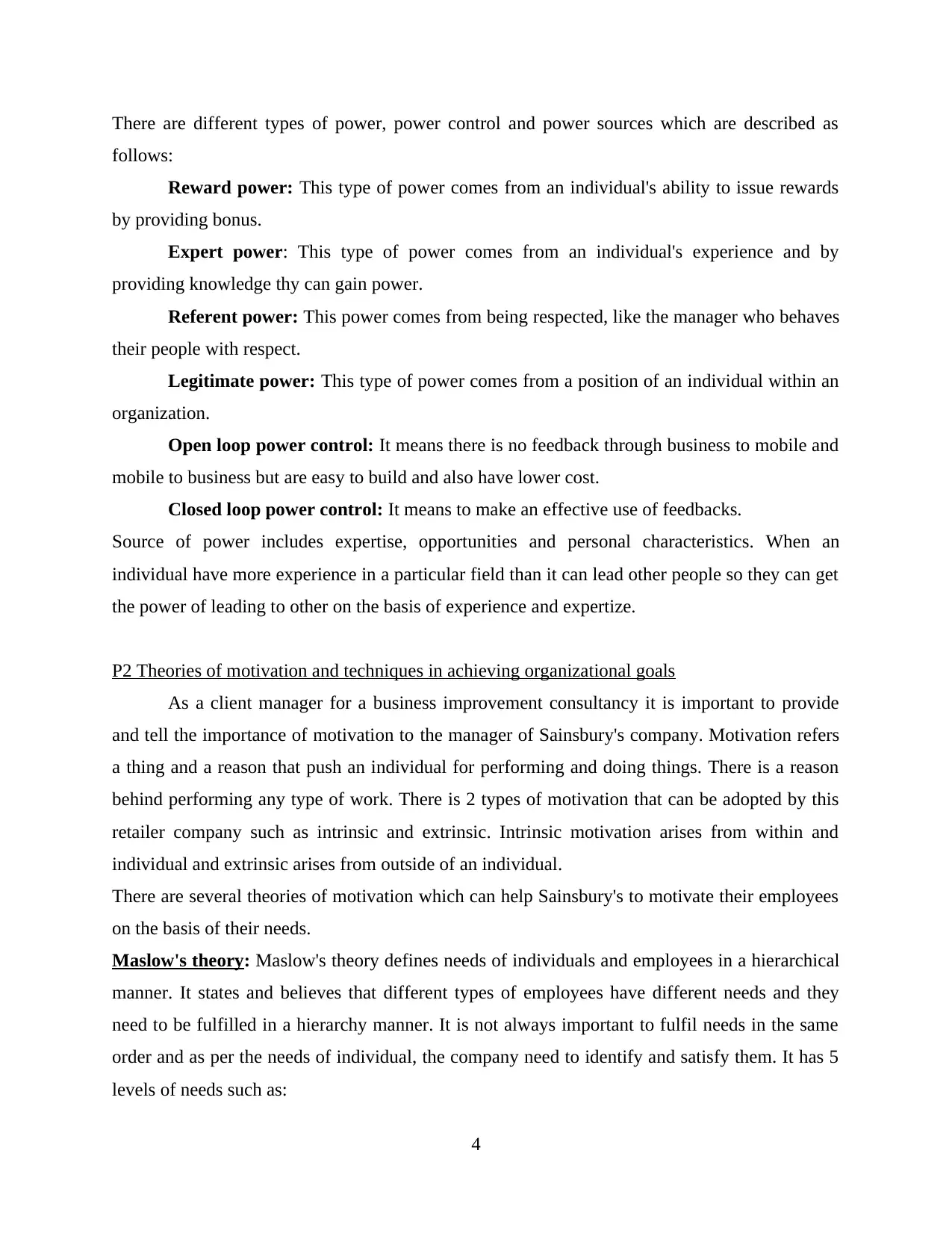
There are different types of power, power control and power sources which are described as
follows:
Reward power: This type of power comes from an individual's ability to issue rewards
by providing bonus.
Expert power: This type of power comes from an individual's experience and by
providing knowledge thy can gain power.
Referent power: This power comes from being respected, like the manager who behaves
their people with respect.
Legitimate power: This type of power comes from a position of an individual within an
organization.
Open loop power control: It means there is no feedback through business to mobile and
mobile to business but are easy to build and also have lower cost.
Closed loop power control: It means to make an effective use of feedbacks.
Source of power includes expertise, opportunities and personal characteristics. When an
individual have more experience in a particular field than it can lead other people so they can get
the power of leading to other on the basis of experience and expertize.
P2 Theories of motivation and techniques in achieving organizational goals
As a client manager for a business improvement consultancy it is important to provide
and tell the importance of motivation to the manager of Sainsbury's company. Motivation refers
a thing and a reason that push an individual for performing and doing things. There is a reason
behind performing any type of work. There is 2 types of motivation that can be adopted by this
retailer company such as intrinsic and extrinsic. Intrinsic motivation arises from within and
individual and extrinsic arises from outside of an individual.
There are several theories of motivation which can help Sainsbury's to motivate their employees
on the basis of their needs.
Maslow's theory: Maslow's theory defines needs of individuals and employees in a hierarchical
manner. It states and believes that different types of employees have different needs and they
need to be fulfilled in a hierarchy manner. It is not always important to fulfil needs in the same
order and as per the needs of individual, the company need to identify and satisfy them. It has 5
levels of needs such as:
4
follows:
Reward power: This type of power comes from an individual's ability to issue rewards
by providing bonus.
Expert power: This type of power comes from an individual's experience and by
providing knowledge thy can gain power.
Referent power: This power comes from being respected, like the manager who behaves
their people with respect.
Legitimate power: This type of power comes from a position of an individual within an
organization.
Open loop power control: It means there is no feedback through business to mobile and
mobile to business but are easy to build and also have lower cost.
Closed loop power control: It means to make an effective use of feedbacks.
Source of power includes expertise, opportunities and personal characteristics. When an
individual have more experience in a particular field than it can lead other people so they can get
the power of leading to other on the basis of experience and expertize.
P2 Theories of motivation and techniques in achieving organizational goals
As a client manager for a business improvement consultancy it is important to provide
and tell the importance of motivation to the manager of Sainsbury's company. Motivation refers
a thing and a reason that push an individual for performing and doing things. There is a reason
behind performing any type of work. There is 2 types of motivation that can be adopted by this
retailer company such as intrinsic and extrinsic. Intrinsic motivation arises from within and
individual and extrinsic arises from outside of an individual.
There are several theories of motivation which can help Sainsbury's to motivate their employees
on the basis of their needs.
Maslow's theory: Maslow's theory defines needs of individuals and employees in a hierarchical
manner. It states and believes that different types of employees have different needs and they
need to be fulfilled in a hierarchy manner. It is not always important to fulfil needs in the same
order and as per the needs of individual, the company need to identify and satisfy them. It has 5
levels of needs such as:
4
⊘ This is a preview!⊘
Do you want full access?
Subscribe today to unlock all pages.

Trusted by 1+ million students worldwide
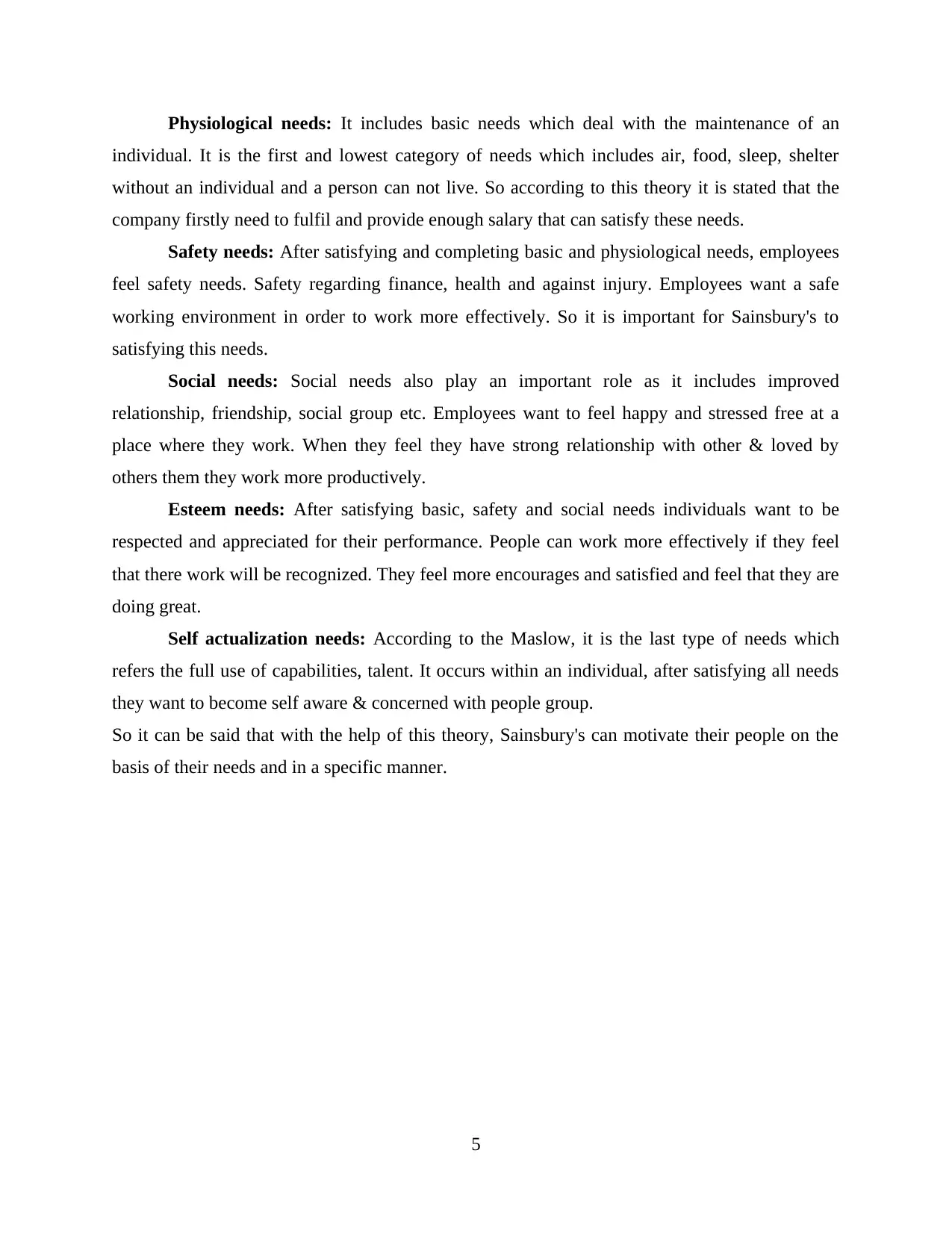
Physiological needs: It includes basic needs which deal with the maintenance of an
individual. It is the first and lowest category of needs which includes air, food, sleep, shelter
without an individual and a person can not live. So according to this theory it is stated that the
company firstly need to fulfil and provide enough salary that can satisfy these needs.
Safety needs: After satisfying and completing basic and physiological needs, employees
feel safety needs. Safety regarding finance, health and against injury. Employees want a safe
working environment in order to work more effectively. So it is important for Sainsbury's to
satisfying this needs.
Social needs: Social needs also play an important role as it includes improved
relationship, friendship, social group etc. Employees want to feel happy and stressed free at a
place where they work. When they feel they have strong relationship with other & loved by
others them they work more productively.
Esteem needs: After satisfying basic, safety and social needs individuals want to be
respected and appreciated for their performance. People can work more effectively if they feel
that there work will be recognized. They feel more encourages and satisfied and feel that they are
doing great.
Self actualization needs: According to the Maslow, it is the last type of needs which
refers the full use of capabilities, talent. It occurs within an individual, after satisfying all needs
they want to become self aware & concerned with people group.
So it can be said that with the help of this theory, Sainsbury's can motivate their people on the
basis of their needs and in a specific manner.
5
individual. It is the first and lowest category of needs which includes air, food, sleep, shelter
without an individual and a person can not live. So according to this theory it is stated that the
company firstly need to fulfil and provide enough salary that can satisfy these needs.
Safety needs: After satisfying and completing basic and physiological needs, employees
feel safety needs. Safety regarding finance, health and against injury. Employees want a safe
working environment in order to work more effectively. So it is important for Sainsbury's to
satisfying this needs.
Social needs: Social needs also play an important role as it includes improved
relationship, friendship, social group etc. Employees want to feel happy and stressed free at a
place where they work. When they feel they have strong relationship with other & loved by
others them they work more productively.
Esteem needs: After satisfying basic, safety and social needs individuals want to be
respected and appreciated for their performance. People can work more effectively if they feel
that there work will be recognized. They feel more encourages and satisfied and feel that they are
doing great.
Self actualization needs: According to the Maslow, it is the last type of needs which
refers the full use of capabilities, talent. It occurs within an individual, after satisfying all needs
they want to become self aware & concerned with people group.
So it can be said that with the help of this theory, Sainsbury's can motivate their people on the
basis of their needs and in a specific manner.
5
Paraphrase This Document
Need a fresh take? Get an instant paraphrase of this document with our AI Paraphraser
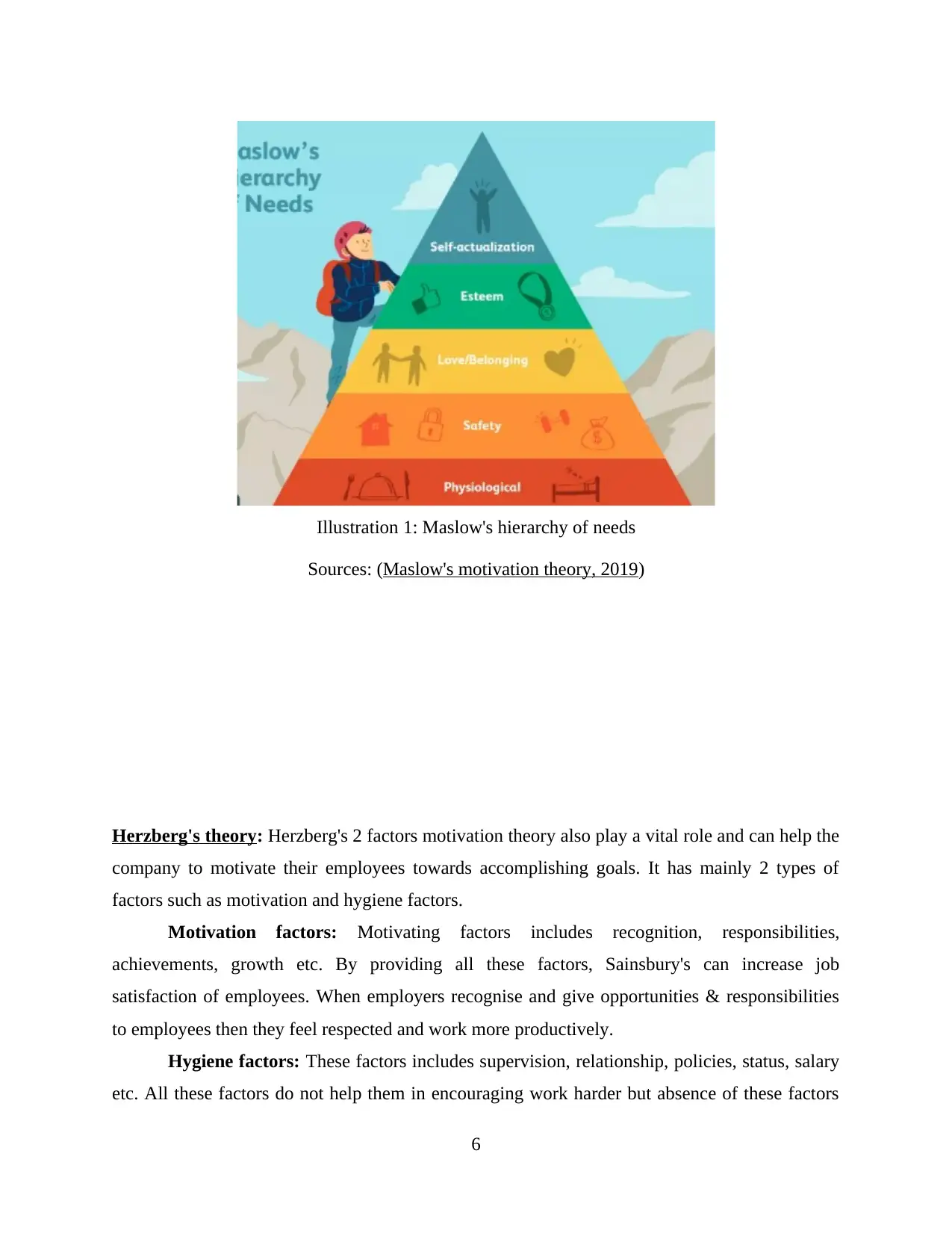
Herzberg's theory: Herzberg's 2 factors motivation theory also play a vital role and can help the
company to motivate their employees towards accomplishing goals. It has mainly 2 types of
factors such as motivation and hygiene factors.
Motivation factors: Motivating factors includes recognition, responsibilities,
achievements, growth etc. By providing all these factors, Sainsbury's can increase job
satisfaction of employees. When employers recognise and give opportunities & responsibilities
to employees then they feel respected and work more productively.
Hygiene factors: These factors includes supervision, relationship, policies, status, salary
etc. All these factors do not help them in encouraging work harder but absence of these factors
6
Illustration 1: Maslow's hierarchy of needs
Sources: (Maslow's motivation theory, 2019)
company to motivate their employees towards accomplishing goals. It has mainly 2 types of
factors such as motivation and hygiene factors.
Motivation factors: Motivating factors includes recognition, responsibilities,
achievements, growth etc. By providing all these factors, Sainsbury's can increase job
satisfaction of employees. When employers recognise and give opportunities & responsibilities
to employees then they feel respected and work more productively.
Hygiene factors: These factors includes supervision, relationship, policies, status, salary
etc. All these factors do not help them in encouraging work harder but absence of these factors
6
Illustration 1: Maslow's hierarchy of needs
Sources: (Maslow's motivation theory, 2019)
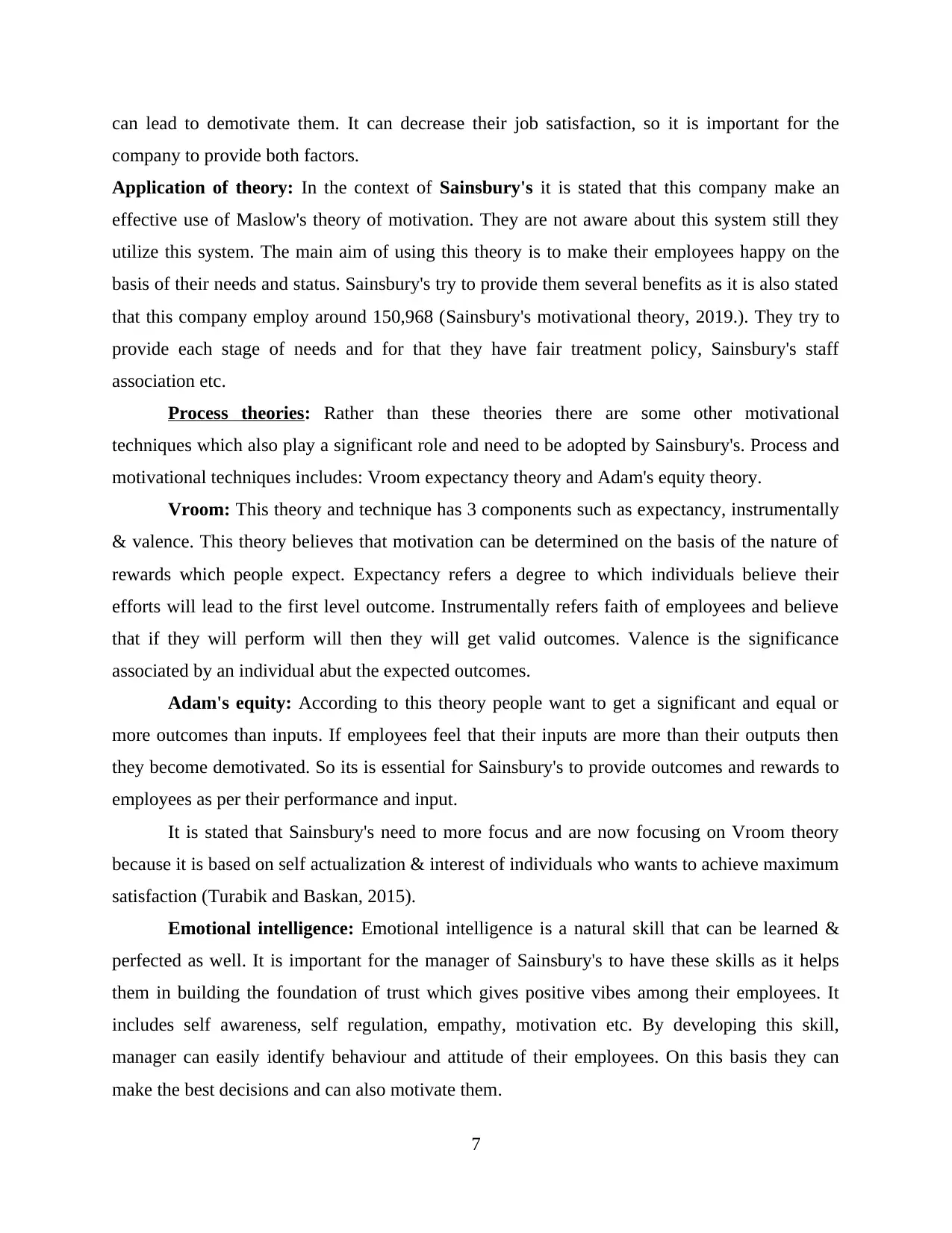
can lead to demotivate them. It can decrease their job satisfaction, so it is important for the
company to provide both factors.
Application of theory: In the context of Sainsbury's it is stated that this company make an
effective use of Maslow's theory of motivation. They are not aware about this system still they
utilize this system. The main aim of using this theory is to make their employees happy on the
basis of their needs and status. Sainsbury's try to provide them several benefits as it is also stated
that this company employ around 150,968 (Sainsbury's motivational theory, 2019.). They try to
provide each stage of needs and for that they have fair treatment policy, Sainsbury's staff
association etc.
Process theories: Rather than these theories there are some other motivational
techniques which also play a significant role and need to be adopted by Sainsbury's. Process and
motivational techniques includes: Vroom expectancy theory and Adam's equity theory.
Vroom: This theory and technique has 3 components such as expectancy, instrumentally
& valence. This theory believes that motivation can be determined on the basis of the nature of
rewards which people expect. Expectancy refers a degree to which individuals believe their
efforts will lead to the first level outcome. Instrumentally refers faith of employees and believe
that if they will perform will then they will get valid outcomes. Valence is the significance
associated by an individual abut the expected outcomes.
Adam's equity: According to this theory people want to get a significant and equal or
more outcomes than inputs. If employees feel that their inputs are more than their outputs then
they become demotivated. So its is essential for Sainsbury's to provide outcomes and rewards to
employees as per their performance and input.
It is stated that Sainsbury's need to more focus and are now focusing on Vroom theory
because it is based on self actualization & interest of individuals who wants to achieve maximum
satisfaction (Turabik and Baskan, 2015).
Emotional intelligence: Emotional intelligence is a natural skill that can be learned &
perfected as well. It is important for the manager of Sainsbury's to have these skills as it helps
them in building the foundation of trust which gives positive vibes among their employees. It
includes self awareness, self regulation, empathy, motivation etc. By developing this skill,
manager can easily identify behaviour and attitude of their employees. On this basis they can
make the best decisions and can also motivate them.
7
company to provide both factors.
Application of theory: In the context of Sainsbury's it is stated that this company make an
effective use of Maslow's theory of motivation. They are not aware about this system still they
utilize this system. The main aim of using this theory is to make their employees happy on the
basis of their needs and status. Sainsbury's try to provide them several benefits as it is also stated
that this company employ around 150,968 (Sainsbury's motivational theory, 2019.). They try to
provide each stage of needs and for that they have fair treatment policy, Sainsbury's staff
association etc.
Process theories: Rather than these theories there are some other motivational
techniques which also play a significant role and need to be adopted by Sainsbury's. Process and
motivational techniques includes: Vroom expectancy theory and Adam's equity theory.
Vroom: This theory and technique has 3 components such as expectancy, instrumentally
& valence. This theory believes that motivation can be determined on the basis of the nature of
rewards which people expect. Expectancy refers a degree to which individuals believe their
efforts will lead to the first level outcome. Instrumentally refers faith of employees and believe
that if they will perform will then they will get valid outcomes. Valence is the significance
associated by an individual abut the expected outcomes.
Adam's equity: According to this theory people want to get a significant and equal or
more outcomes than inputs. If employees feel that their inputs are more than their outputs then
they become demotivated. So its is essential for Sainsbury's to provide outcomes and rewards to
employees as per their performance and input.
It is stated that Sainsbury's need to more focus and are now focusing on Vroom theory
because it is based on self actualization & interest of individuals who wants to achieve maximum
satisfaction (Turabik and Baskan, 2015).
Emotional intelligence: Emotional intelligence is a natural skill that can be learned &
perfected as well. It is important for the manager of Sainsbury's to have these skills as it helps
them in building the foundation of trust which gives positive vibes among their employees. It
includes self awareness, self regulation, empathy, motivation etc. By developing this skill,
manager can easily identify behaviour and attitude of their employees. On this basis they can
make the best decisions and can also motivate them.
7
⊘ This is a preview!⊘
Do you want full access?
Subscribe today to unlock all pages.

Trusted by 1+ million students worldwide
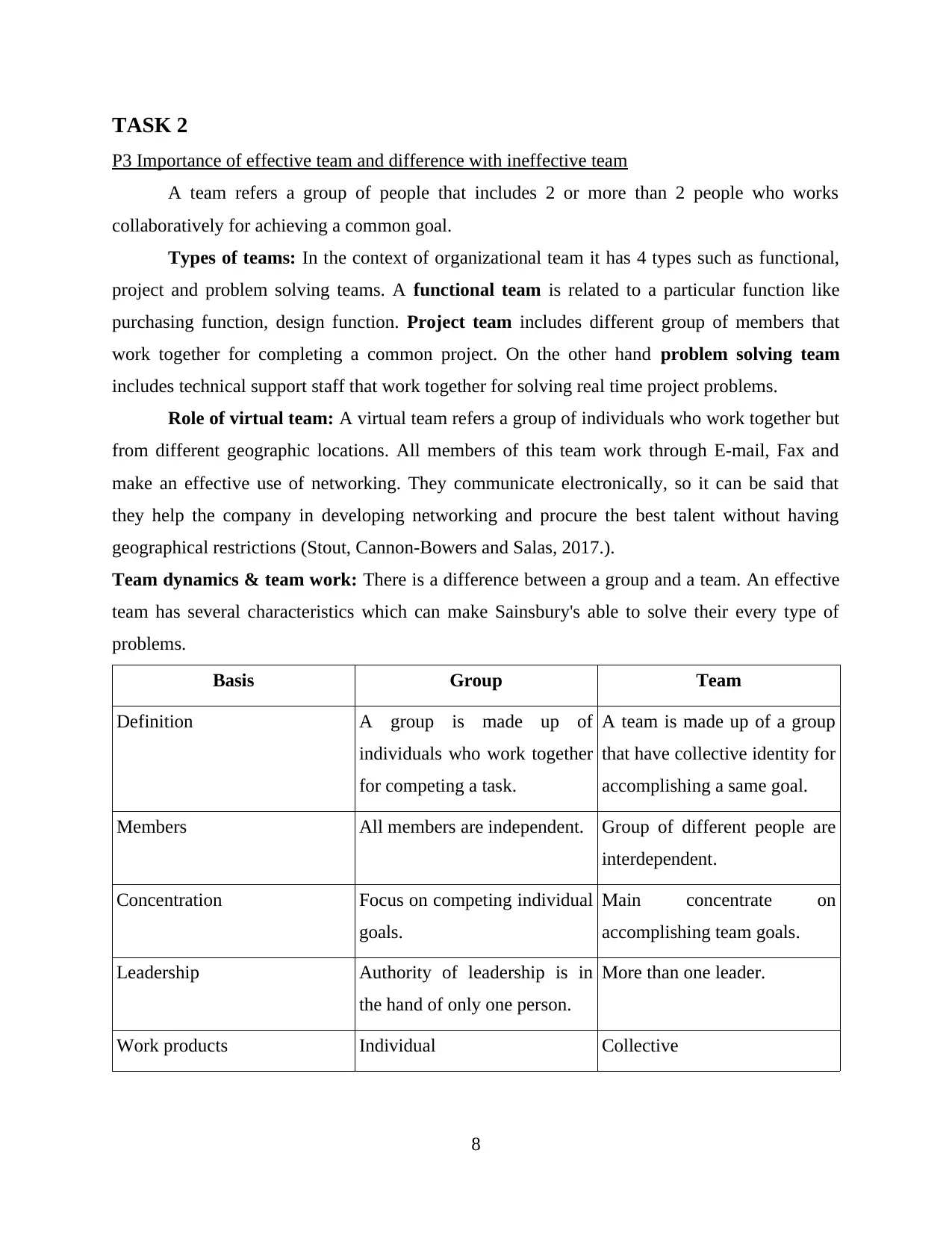
TASK 2
P3 Importance of effective team and difference with ineffective team
A team refers a group of people that includes 2 or more than 2 people who works
collaboratively for achieving a common goal.
Types of teams: In the context of organizational team it has 4 types such as functional,
project and problem solving teams. A functional team is related to a particular function like
purchasing function, design function. Project team includes different group of members that
work together for completing a common project. On the other hand problem solving team
includes technical support staff that work together for solving real time project problems.
Role of virtual team: A virtual team refers a group of individuals who work together but
from different geographic locations. All members of this team work through E-mail, Fax and
make an effective use of networking. They communicate electronically, so it can be said that
they help the company in developing networking and procure the best talent without having
geographical restrictions (Stout, Cannon-Bowers and Salas, 2017.).
Team dynamics & team work: There is a difference between a group and a team. An effective
team has several characteristics which can make Sainsbury's able to solve their every type of
problems.
Basis Group Team
Definition A group is made up of
individuals who work together
for competing a task.
A team is made up of a group
that have collective identity for
accomplishing a same goal.
Members All members are independent. Group of different people are
interdependent.
Concentration Focus on competing individual
goals.
Main concentrate on
accomplishing team goals.
Leadership Authority of leadership is in
the hand of only one person.
More than one leader.
Work products Individual Collective
8
P3 Importance of effective team and difference with ineffective team
A team refers a group of people that includes 2 or more than 2 people who works
collaboratively for achieving a common goal.
Types of teams: In the context of organizational team it has 4 types such as functional,
project and problem solving teams. A functional team is related to a particular function like
purchasing function, design function. Project team includes different group of members that
work together for completing a common project. On the other hand problem solving team
includes technical support staff that work together for solving real time project problems.
Role of virtual team: A virtual team refers a group of individuals who work together but
from different geographic locations. All members of this team work through E-mail, Fax and
make an effective use of networking. They communicate electronically, so it can be said that
they help the company in developing networking and procure the best talent without having
geographical restrictions (Stout, Cannon-Bowers and Salas, 2017.).
Team dynamics & team work: There is a difference between a group and a team. An effective
team has several characteristics which can make Sainsbury's able to solve their every type of
problems.
Basis Group Team
Definition A group is made up of
individuals who work together
for competing a task.
A team is made up of a group
that have collective identity for
accomplishing a same goal.
Members All members are independent. Group of different people are
interdependent.
Concentration Focus on competing individual
goals.
Main concentrate on
accomplishing team goals.
Leadership Authority of leadership is in
the hand of only one person.
More than one leader.
Work products Individual Collective
8
Paraphrase This Document
Need a fresh take? Get an instant paraphrase of this document with our AI Paraphraser
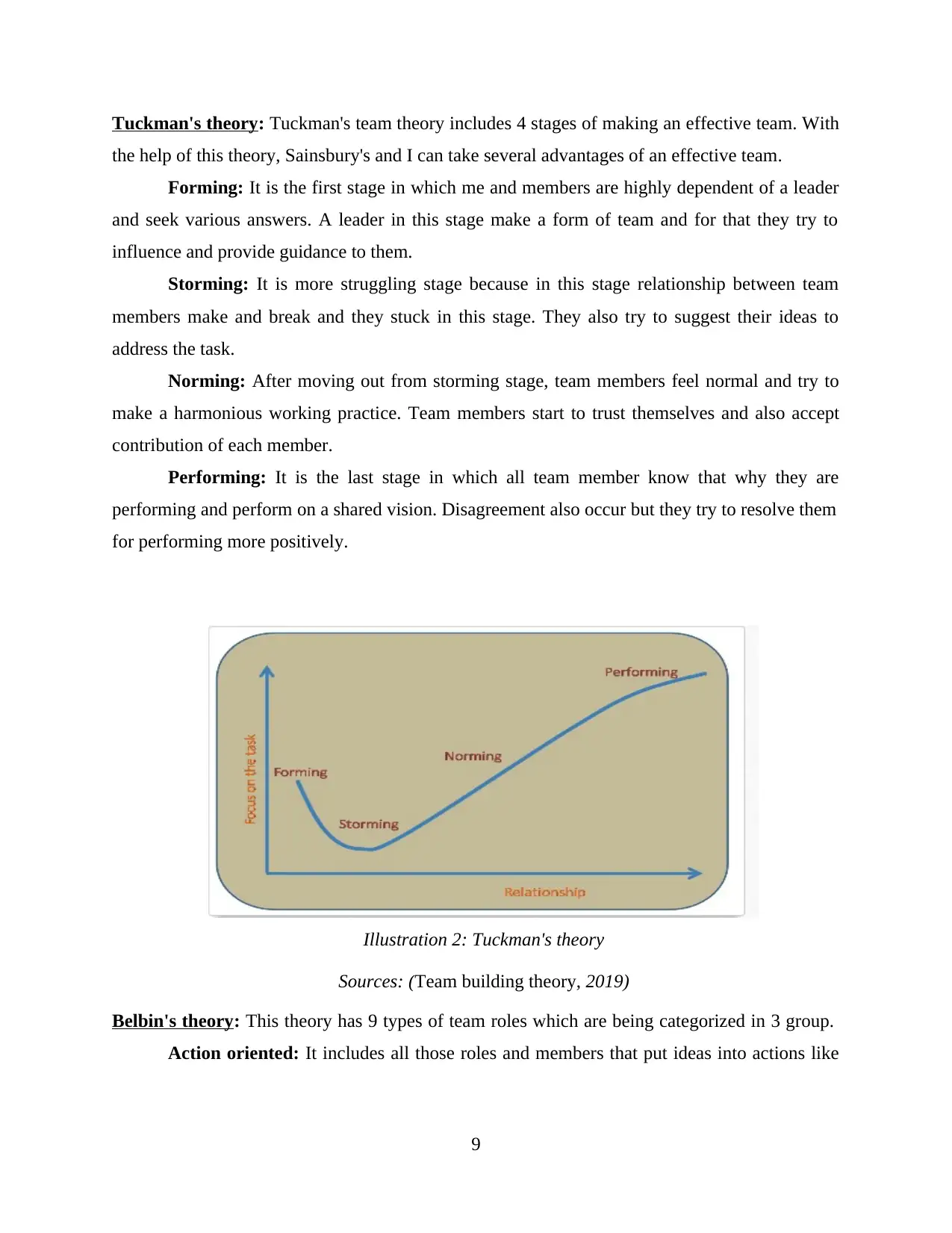
Tuckman's theory: Tuckman's team theory includes 4 stages of making an effective team. With
the help of this theory, Sainsbury's and I can take several advantages of an effective team.
Forming: It is the first stage in which me and members are highly dependent of a leader
and seek various answers. A leader in this stage make a form of team and for that they try to
influence and provide guidance to them.
Storming: It is more struggling stage because in this stage relationship between team
members make and break and they stuck in this stage. They also try to suggest their ideas to
address the task.
Norming: After moving out from storming stage, team members feel normal and try to
make a harmonious working practice. Team members start to trust themselves and also accept
contribution of each member.
Performing: It is the last stage in which all team member know that why they are
performing and perform on a shared vision. Disagreement also occur but they try to resolve them
for performing more positively.
Belbin's theory: This theory has 9 types of team roles which are being categorized in 3 group.
Action oriented: It includes all those roles and members that put ideas into actions like
9
Illustration 2: Tuckman's theory
Sources: (Team building theory, 2019)
the help of this theory, Sainsbury's and I can take several advantages of an effective team.
Forming: It is the first stage in which me and members are highly dependent of a leader
and seek various answers. A leader in this stage make a form of team and for that they try to
influence and provide guidance to them.
Storming: It is more struggling stage because in this stage relationship between team
members make and break and they stuck in this stage. They also try to suggest their ideas to
address the task.
Norming: After moving out from storming stage, team members feel normal and try to
make a harmonious working practice. Team members start to trust themselves and also accept
contribution of each member.
Performing: It is the last stage in which all team member know that why they are
performing and perform on a shared vision. Disagreement also occur but they try to resolve them
for performing more positively.
Belbin's theory: This theory has 9 types of team roles which are being categorized in 3 group.
Action oriented: It includes all those roles and members that put ideas into actions like
9
Illustration 2: Tuckman's theory
Sources: (Team building theory, 2019)
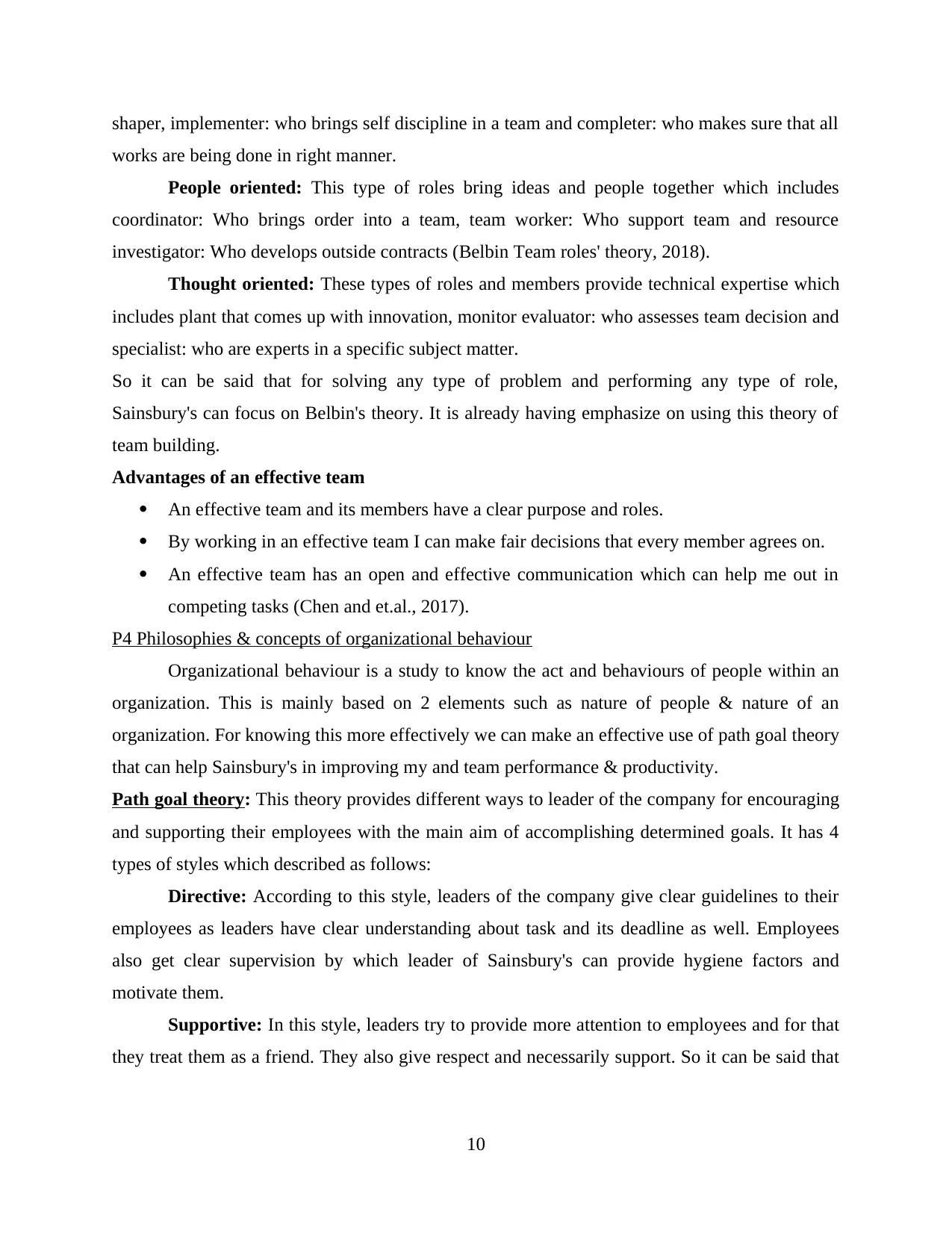
shaper, implementer: who brings self discipline in a team and completer: who makes sure that all
works are being done in right manner.
People oriented: This type of roles bring ideas and people together which includes
coordinator: Who brings order into a team, team worker: Who support team and resource
investigator: Who develops outside contracts (Belbin Team roles' theory, 2018).
Thought oriented: These types of roles and members provide technical expertise which
includes plant that comes up with innovation, monitor evaluator: who assesses team decision and
specialist: who are experts in a specific subject matter.
So it can be said that for solving any type of problem and performing any type of role,
Sainsbury's can focus on Belbin's theory. It is already having emphasize on using this theory of
team building.
Advantages of an effective team
An effective team and its members have a clear purpose and roles.
By working in an effective team I can make fair decisions that every member agrees on.
An effective team has an open and effective communication which can help me out in
competing tasks (Chen and et.al., 2017).
P4 Philosophies & concepts of organizational behaviour
Organizational behaviour is a study to know the act and behaviours of people within an
organization. This is mainly based on 2 elements such as nature of people & nature of an
organization. For knowing this more effectively we can make an effective use of path goal theory
that can help Sainsbury's in improving my and team performance & productivity.
Path goal theory: This theory provides different ways to leader of the company for encouraging
and supporting their employees with the main aim of accomplishing determined goals. It has 4
types of styles which described as follows:
Directive: According to this style, leaders of the company give clear guidelines to their
employees as leaders have clear understanding about task and its deadline as well. Employees
also get clear supervision by which leader of Sainsbury's can provide hygiene factors and
motivate them.
Supportive: In this style, leaders try to provide more attention to employees and for that
they treat them as a friend. They also give respect and necessarily support. So it can be said that
10
works are being done in right manner.
People oriented: This type of roles bring ideas and people together which includes
coordinator: Who brings order into a team, team worker: Who support team and resource
investigator: Who develops outside contracts (Belbin Team roles' theory, 2018).
Thought oriented: These types of roles and members provide technical expertise which
includes plant that comes up with innovation, monitor evaluator: who assesses team decision and
specialist: who are experts in a specific subject matter.
So it can be said that for solving any type of problem and performing any type of role,
Sainsbury's can focus on Belbin's theory. It is already having emphasize on using this theory of
team building.
Advantages of an effective team
An effective team and its members have a clear purpose and roles.
By working in an effective team I can make fair decisions that every member agrees on.
An effective team has an open and effective communication which can help me out in
competing tasks (Chen and et.al., 2017).
P4 Philosophies & concepts of organizational behaviour
Organizational behaviour is a study to know the act and behaviours of people within an
organization. This is mainly based on 2 elements such as nature of people & nature of an
organization. For knowing this more effectively we can make an effective use of path goal theory
that can help Sainsbury's in improving my and team performance & productivity.
Path goal theory: This theory provides different ways to leader of the company for encouraging
and supporting their employees with the main aim of accomplishing determined goals. It has 4
types of styles which described as follows:
Directive: According to this style, leaders of the company give clear guidelines to their
employees as leaders have clear understanding about task and its deadline as well. Employees
also get clear supervision by which leader of Sainsbury's can provide hygiene factors and
motivate them.
Supportive: In this style, leaders try to provide more attention to employees and for that
they treat them as a friend. They also give respect and necessarily support. So it can be said that
10
⊘ This is a preview!⊘
Do you want full access?
Subscribe today to unlock all pages.

Trusted by 1+ million students worldwide
1 out of 19
Related Documents
Your All-in-One AI-Powered Toolkit for Academic Success.
+13062052269
info@desklib.com
Available 24*7 on WhatsApp / Email
![[object Object]](/_next/static/media/star-bottom.7253800d.svg)
Unlock your academic potential
Copyright © 2020–2025 A2Z Services. All Rights Reserved. Developed and managed by ZUCOL.




